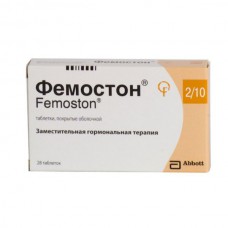Expiration date: 04/2025
Structure and Composition:
Film-coated tablets set.
1 white tablet contains: Estradiol 1 mg
1 gray tablet contains:
Estradiol 1 mg
10 mg dydrogesterone
Excipients: lactose monohydrate, corn starch Silicon Hypromellose stearate Opadry OY-1-7000 dioxide colloidal magnesium white (only white tablets) of Opadry OY-8243 gray (only for gray tablets)
in blister 28 pcs. (14 and 14 gray white) in the stack of cardboard 1, 3 or 10 blisters.
Film-coated tablets set.
1 pink tablet contains: 2mg oestradiol
1 tablet light yellow contains:
2mg oestradiol
10 mg dydrogesterone
Excipients: stearate Opadry OY-6957 lactose monohydrate hypromellose corn starch colloidal silicon dioxide magnesium pink (pink for tablets only), Opadry OY-02B22764 yellow (for light yellow tablets)
in blister 28 pcs. (14 and 14 light pink and yellow) in the stack of cardboard 1, 3 or 10 blisters.
Description pharmaceutical form:
Estradiol 1 mg Tablets: round, biconvex, film-coated white, embossed «S» of the symbol "6" on one side and embossed "379" - on the other.
Tablets 1 mg estradiol / dydrogesterone 10 mg: Round, biconvex, film-coated gray, embossed «S» of the symbol "6" on one side and embossed "379" - on the other.
white tablet core.
Estradiol Tablets 2 mg: Round, biconvex, film-coated pink, embossed «S» of the symbol "6" on one side and embossed "379" - on the other.
white tablet core.
Tablets 2 mg estradiol / mg Dydrogesterone 10: Round, biconvex, coated pale yellow embossed «S» over the icon "6" on one side and "379" - on the other side.
white tablet core.
Characteristic:
Drug for hormone replacement therapy with normal (2/10) and low-dose (1/10) content as the estrogen component - estradiol, as the progestin component - dydrogesterone.
Pharmacokinetics:
After oral administration, micronized estradiol is readily absorbed. It is metabolized in the liver to estrone, and estrone sulfate, which is also subject to hepatic biotransformation. Glucuronides of estrone and estradiol are derived mainly from the urine.
Didrogesteron after ingestion is rapidly absorbed from the gastrointestinal tract. Metabolized completely. The major metabolite - 20 digidrodidrogesteron present in the urine mainly as glucuronic acid conjugate. Complete removal of dydrogesterone occurs after 72 hours.
Description of the pharmacological actions:
Estradiol - estrogen, which is part of the preparation Femoston identical to endogenous human estradiol. Estradiol restores deficit of estrogen in the female body after menopause and provide effective treatment for psycho-emotional and vegetative menopausal symptoms, "tides", increased sweating, sleep disturbances, increased nervous irritability, dizziness, headache, involution of the skin and mucous membranes, especially the mucous membranes of the genitourinary system (dryness and irritation of the mucous membrane of the vagina, pain during sexual intercourse). Hormone replacement therapy (HRT) drug Femoston prevents bone loss in post-menopausal, caused by estrogen deficiency. Admission Femoston preparation leads to a change in the lipid profile in the direction of reducing total cholesterol and LDL and increase HDL.
Dydrogesterone is a progestogen that is effective when taken orally, which fully meets the offensive phase of the secretion of the endometrium, thereby reducing the risk of endometrial hyperplasia and / or carcinogenesis, against the backdrop of rising estrogen. Dydrogesterone has no estrogenic, androgenic, or anabolic glucocorticosteroid activity.
The combination of 1 mg estradiol dydrogesterone is a modern low-dose HRT regimen.
Indications:
- HRT in disorders caused by natural or as a result of the ensuing surgical menopause
- prevention of postmenopausal osteoporosis.
Contraindications:
- established or suspected pregnancy
- breastfeeding
- diagnosed or suspected breast cancer, breast cancer in anamnesis
- diagnosed or suspected estrogen-dependent malignant tumors
- vaginal bleeding of unknown etiology
- previous idiopathic or confirmed thrombosis veins (deep vein thrombosis, pulmonary vessels)
- active or recent arterial thromboembolism
- acute liver disease, and liver disease in history (up to normalization of laboratory values ??of liver function)
- Untreated endometrial hyperplasia
- hypersensitivity to any component of the drug
- porphyria.
With care - the patient receiving HRT and have listed below the state (currently or in the past) should be under close medical supervision:
- uterine leiomyoma, endometriosis
- thrombosis or a history of risk factors
- risks of estrogen dependent tumors (e.g. breast cancer, the patient's mother)
- arterial hypertension
- benign liver tumor
- diabetes
- cholelithiasis
- epilepsy
- migraine or severe headache
- endometrial hyperplasia in history
- systemic lupus erythematosus
- bronchial asthma
- kidney failure
- otosclerosis.
After consultation with the doctor receiving the drug should be discontinued in such cases as:
- jaundice or deterioration of liver function
- strong rise in blood pressure
- newly diagnosed migraine attack
- pregnancy
- demonstration of any contraindications.
Application of pregnancy and breastfeeding:
Contraindicated in pregnancy and during breastfeeding.
Side effect:
Co side of the blood and lymphatic system: very rarely (<0.01%) - hemolytic anemia.
From the nervous system: headache, migraine (1-10%), sometimes (in 0.1-1%) - dizziness, nervousness, depression, libido change very rarely - chorea.
Since the cardiovascular system: sometimes - venous thromboembolism is very rare - myocardial infarction.
On the part of the digestive tract: nausea, abdominal pain, flatulence, very rarely - vomiting.
On the part of the liver and biliary tract: sometimes - rarely cholecystitis (in 0.01-0.1%) - abnormal liver function, sometimes accompanied by asthenia, malaise, jaundice and abdominal pain.
Skin and subcutaneous adipose tissue: sometimes - allergic reactions, rash, urticaria, pruritus, peripheral edema, very rarely - chloasma, melasma, erythema multiforme, erythema nodosum, haemorrhagic purpura, angioedema.
Reproductive system and breast: breast tenderness, breakthrough bleeding, pelvic pain sometimes - changes in cervical erosion, changes in secretion, dysmenorrhea rarely - breast enlargement, predmenstrualnopodobny syndrome.
Other: sometimes change in body weight - vaginal candidiasis, breast carcinoma, leiomyoma increase in the amount of rare - intolerance to contact lenses, increasing the curvature of the cornea is very rare - the aggravation of porphyria (<0.01%).
Drug Interactions:
Drugs that are inducers of microsomal liver enzymes (barbiturates, phenytoin, rifampin, rifabutin, carbamazepine) may reduce estrogenic effects Femoston drug. Ritonavir and nelfinavir, although known as inhibitors of microsomal metabolism, can play the role of inductors while admission to steroid hormones. Preparations on the basis of herbs containing St. John's wort, can stimulate the exchange of estrogens and progestogens.
Dydrogesterone Interactions with other medicines are not known.
The patient should inform the doctor about the medications that she takes a moment or took up appointment Femoston drug.
Dosage and administration:
Inside, preferably at the same time of the day regardless of the meal - Table 1. a day without interruption. Femoston take 1/10 as follows: In the first 14 days of the 28 day cycle at a daily take one white tablet (half of the "1" packaging arrow labeled figure) containing 1 mg of estradiol, in the remaining 14 days - 1 day sulfur tablet (half of "2" packaging arrow labeled figure) containing 1 mg estradiol and 10 mg dydrogesterone.
Femoston take 2/10 as follows: in the first 14 days of a 28 day cycle, take 1 tablet daily. pink color (from half of the package arrow labeled number "1"), containing 2 mg of estradiol, and the remaining 14 days - daily 1 light yellow tablet (one-half of the arrow packaging labeled "2" digit) containing 2 mg of estradiol and 10 mg dydrogesterone.
Patients who have ceased menstruation is not recommended to start treatment in the first day of the menstrual cycle (the 1st day of menstruation). Patients with irregular menstrual cycle it is advisable to start the treatment after 10-14 days of monotherapy using progestogen. Patients whose last menstrual period was observed over 1 year ago, may start treatment at any time.
Overdose:
Symptoms include nausea, vomiting, drowsiness, dizziness.
Treatment: symptomatic.
Special instructions:
Before the appointment or renewal of HRT need to collect a complete medical and family history and to hold general and gynecological examination in order to identify possible contraindications and conditions requiring precautions. At the time of treatment is recommended to periodically examine women (frequency and nature of the research is determined individually). In addition, it is advisable to carry out a study of breast and / or a mammogram in line with accepted standards, taking into account clinical indications. The use of estrogen can influence the results of these laboratory tests: determination of glucose tolerance study thyroid and liver.
Generally recognized risk factors for thrombosis and thromboembolism in patients receiving HRT are thromboembolic events in history, severe obesity (body mass index over 30 kg / m2) and systemic lupus erythematosus. Regarding the role of varicose veins in the development of thromboembolic events is not generally accepted opinion.
The risk of developing deep vein thrombosis may be temporarily increased with prolonged immobilization, major trauma or surgery. In cases where long-term immobilization is needed after surgery, should be considered a temporary cessation of HRT for 4-6 weeks prior to surgery.
When deciding on hormone therapy in patients with recurrent deep vein thrombosis or thromboembolism treated with anticoagulants, it is necessary to carefully evaluate the benefits and risks of HRT.
If thrombosis developed after initiation of hormone replacement therapy, the drug should be discontinued. The patient should be informed of the need to see a doctor in the event of the following symptoms: painful swelling of the lower limbs, sudden loss of consciousness, dyspnea, impaired vision.
There are data that show a slight increase in the detection rate of breast cancer in women, long-term (over 10 years) treated with HRT. The probability of diagnosing breast cancer increases with duration of treatment and returned to normal after 5 years after stopping HRT.
Patients previously treated with HRT with estrogen drugs only need to be very carefully examined before treatment to identify a possible hyperstimulation of the endometrium. Breakthrough uterine bleeding and mild expressed menstrualnopodobnye bleeding may occur during the first months of drug treatment. If, despite dose adjustments like bleeding does not stop, the drug should be withdrawn to determine the cause of bleeding. If the bleeding recurs after a period of amenorrhea or persists after discontinuation of treatment should be to establish its etiology. This may require a biopsy of the endometrium.
Femoston The drug is not a contraceptive. Patients in the perimenopausal recommended to use non-hormonal contraception.
Effects on ability to drive the car and the other mechanisms do not provide.
Femoston
2/10
(Dydrogesterone
Estradiol)
28
tablets
- Brand: Abbott

- Availability:
in stock
Categories:
-
$29.00

